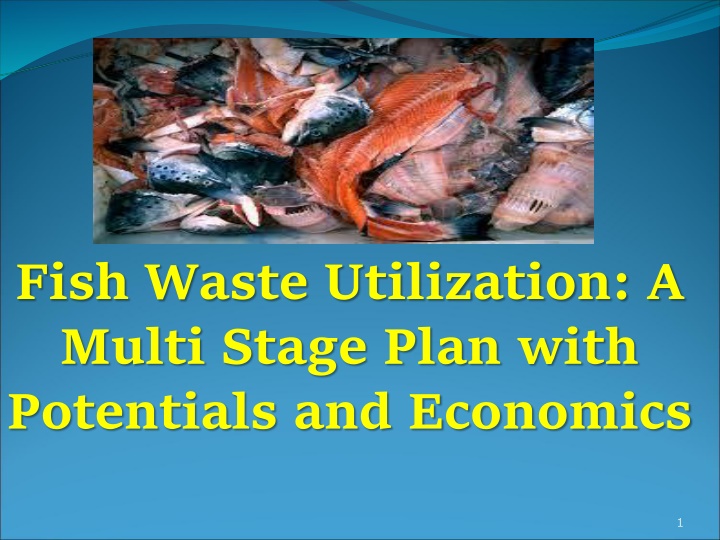
Fish Waste Utilization: A Comprehensive Overview
This multi-stage plan discusses the availability, present and potential uses of fish by-products, along with economic considerations and strategies for their utilization. It covers industry surveys, seasonality, company profiles, and mapping of by-product availability and utilization routes.
Download Presentation

Please find below an Image/Link to download the presentation.
The content on the website is provided AS IS for your information and personal use only. It may not be sold, licensed, or shared on other websites without obtaining consent from the author. If you encounter any issues during the download, it is possible that the publisher has removed the file from their server.
You are allowed to download the files provided on this website for personal or commercial use, subject to the condition that they are used lawfully. All files are the property of their respective owners.
The content on the website is provided AS IS for your information and personal use only. It may not be sold, licensed, or shared on other websites without obtaining consent from the author.
E N D
Presentation Transcript
Fish Waste Utilization: A Multi Stage Plan with Potentials and Economics 1
The Plan 1/ What is the availability of fish by-products ? 2/ The present uses of the by-products 3/ The potential uses of the by-products 4/ Some basic economics to consider for food fishery by-products uses 5/ Elaborating a strategy 2
1/ What is the availability of fish by-products ? Doing an industry survey in the fisheries sector and the seafood processing industry What ? Fresh finfish : Heading, gutting, skinning, filleting, cutting . On shore (off-shore) Main species, main by-products and yields of by-products Fresh shellfish Cooking, peeling, extracting flesh of crustacean; Main species, main by-products and yields of by-products shucking bivalves Fish canneries By-products generated from raw fish or from pre-cooked fish Fish smoking factories Heading, gutting, skinning, filleting on raw material Main species, main by-products and yields of by-products Fish-based frozen products (pieces or dishes) Main species, main by-products and yields of by-products Other fish processing units Main species, main by-products and yields of by-products C. 3
1/ What is the availability of fish by-products ? (2) When ? Seasonality for the main species Who ? Main companies by type of activity Where ? Geographical localization of fish processing plants Concentration vs atomization ? C. 4
1/ What is the availability of fish by-products ? Results Estimating the overall quantity, the main origins and types, the variation in availability Mathematically, the volume of by-products from a food fishery is determined by the harvest volume and 2 yield percentages: Food fish harvest volume x Percent of food fish volume for which byproducts are available = Food fishery volume for which byproducts are available x Byproducts yield = Byproducts volume Understanding the ability and constraints to sort by-products according to future uses Mapping the availability of by-products Understanding the present routes of byproducts 5
2/ The present uses of the by-products Food on local market or export income Feed on local market income or 0 Processing into : fish meal & fish oil, others income Disposal on land or at sea (= wastes) cost C. 6
3/ The potential uses of by-products Products and technologies : options and hierarchy cf speech of Jean-Pascal BERGE Markets: local or export, demand and competition, prices of final products, costs for storage and transport Legislation: In producing country: food hygiene legislation, waste legislation (storage, transport, disposal), by-products raw materials and permitted treatments In targeted market countries for the different final products: food, feed, agriculture fertilizers, nutraceutical and pharmaceutical products, Environmental impacts: solid or liquid waste, odour, noise, transport, airborne pollution, water pollution, energy use, water use, space requirements C. 7
4/ Some basic economics to consider for food fishery byproducts uses Profit maximization for primary food products drives fundamental economic choices for food fish processors: Species processed Timing of production Locations of facilities Scale of facilities Product mix Product yields Optimal economic choices for food fish production are not necessarily optimal for by-products production and utilization 8
4/ Some basic economics to consider for food fishery byproducts uses (2) The scale needed for profitable processing of byproducts is likely to be higher than for food fish production. Larger scale production is needed because of: Higher relative capital costs Lower relative unit values Lower yield from harvest volume Higher volume requirements of buyers For food fish processors, using the food fish byproducts may be unprofitable: If the scale of production is too low If production is too seasonal 9
4/ Some basic economics to consider (3) Selected factors which affect the likelihood of making alternative products with byproducts from a food fishery Factor Effect Increase Increasing prices of final products issued from byproducts Increasing costs of fish waste disposal Government subsidies for byproduct utilization Government policies for byproduct utilization Consolidation of processing into fewer and larger plants Even flow of product over the year Increasing yields in food fish processing Increasing energy and labor costs Increasing food uses of fish byproducts C. Mariojouls, Noum a June 11th 2012 Increase Increase Increase Increase Increase Decrease Decrease Decrease 10
5/ Elaborating a strategy By-products and wastes initial survey Concerned actors: strategies and organization R&D Government policies and subsidies Projects planning and comparison: timescale for management options, scale of unit, costs (capital, running, per T) and returns, profitability A strategy for several years and terms 11
